| Article ID | Journal | Published Year | Pages | File Type |
|---|---|---|---|---|
| 3007084 | Progress in Pediatric Cardiology | 2016 | 6 Pages |
Cardiomyopathy is the leading diagnosis for pediatric heart transplantation in children over 1 year of age. The majority of these patients usually have dilated cardiomyopathy. Children with hypertrophic and restrictive types of cardiomyopathy comprise less than 20% of the total children transplanted. Hypertrophic cardiomyopathy is the smallest subgroup to receive a cardiac transplant (6%). The mean age at listing in the Pediatric Heart Transplant Study (PHTS) was 7.6 years; however, 39% were infants listed at a mean of 3.2 ± 2.8 months of age. A patient with hypertrophic cardiomyopathy older than 1 year had low waitlist mortality and survival after transplant was no different than dilated or non-cardiomyopathy patients. The infant subgroup had the poorest overall survival with waitlist mortality of 33%, within a few months after listing. Restrictive cardiomyopathy is the rarest type of cardiomyopathy (2–5%) but accounts for 11% of children transplanted with cardiomyopathy in PHTS. Survival after listing in infants < 1 year of age with either hypertrophic or restrictive cardiomyopathy was poor, 50% at 1 year compared with 80% in infants with dilated cardiomyopathy. The mean age at listing for restrictive patients in PHTS was 8.1 years, 81% were transplanted and 9% died waiting (40% of pre-transplant deaths were infants < 1 year). The 1 and 5 year survival was 89 and 77%, similar to other cardiomyopathy patients and better than non-cardiomyopathy patients. Risk factors and clinical profiles leading to listing are discussed.
